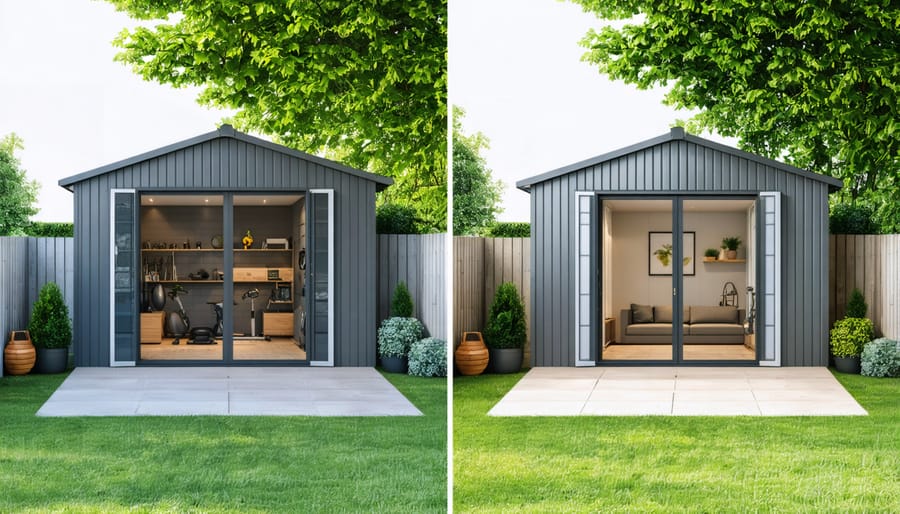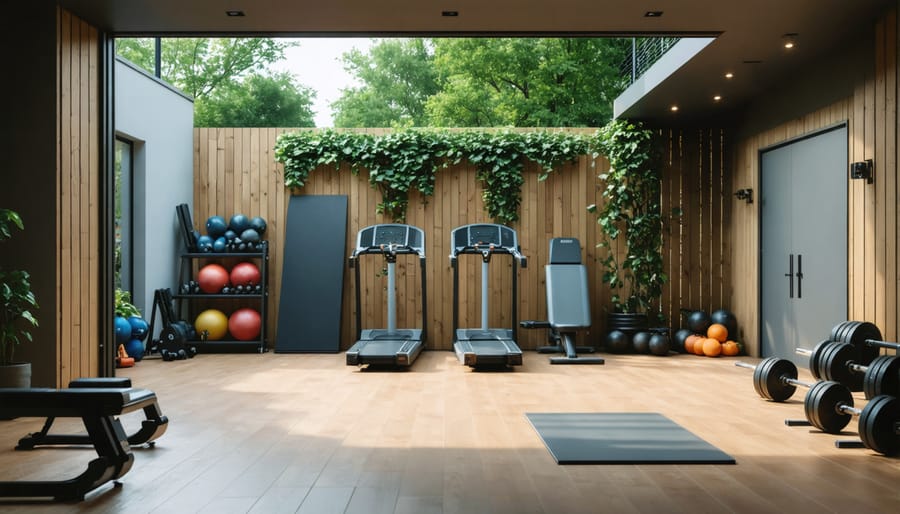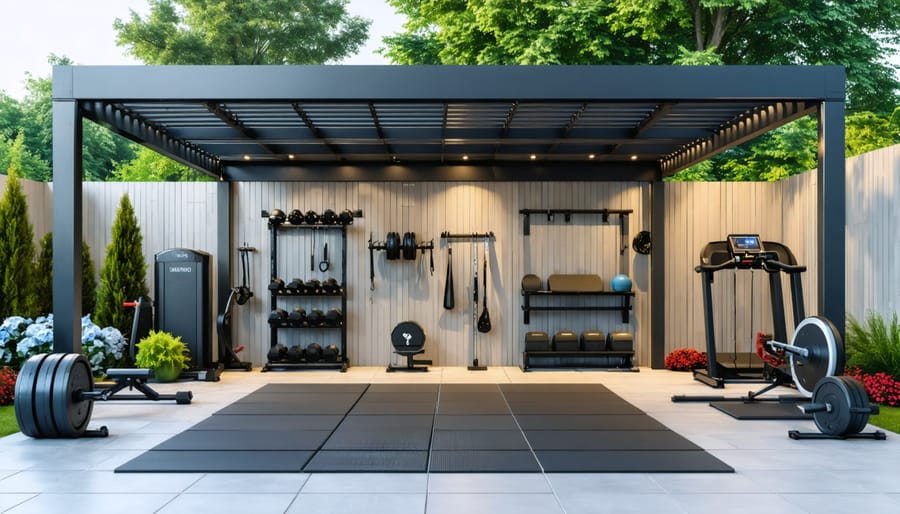Transform your backyard into a professional-grade personal home gym setup that rivals commercial facilities, without the monthly membership fees or commute time. Create dedicated zones for cardio, strength training, and recovery by strategically positioning weather-resistant equipment under a sturdy pergola or converted shed space. Install rubber matting or specialized outdoor flooring to ensure proper shock absorption and equipment stability while protecting your investment from ground moisture and weather elements. Choose multi-functional equipment like pull-up bars, resistance bands, and adjustable dumbbells to maximize your training options without overwhelming your outdoor space. Smart design choices, such as vertical storage solutions and retractable awnings, enable year-round workouts while maintaining your backyard’s aesthetic appeal. With proper planning and equipment selection, your outdoor gym becomes a permanent fixture that enhances both your property value and your daily fitness routine.
Planning Your Backyard Gym Shed

Choosing the Right Shed Size and Style
When planning your backyard gym shed, size selection is crucial for a comfortable workout experience. For a basic setup with free weights and a bench, aim for at least 10×12 feet. If you’re including cardio equipment like a treadmill or rowing machine, consider upgrading to 12×16 feet or larger to ensure adequate space for movement and safety zones around equipment.
Style-wise, opt for designs that maximize ventilation and natural light. A barn-style shed with high ceilings accommodates tall equipment and promotes better airflow, while gable windows or skylights reduce dependency on artificial lighting. Consider double doors (at least 6 feet wide) for easy equipment movement and installation.
Look for sheds with reinforced flooring to support heavy equipment, and ensure the roof pitch allows for proper drainage. Modern ranch-style sheds work well for a clean, contemporary look, while traditional garden shed designs help your gym blend seamlessly with existing landscaping. Remember to factor in space for storage solutions like wall-mounted racks and shelving to keep your workout area organized and clutter-free.
Foundation and Flooring Requirements
Before installing your outdoor gym equipment, proper site preparation is essential for safety and longevity. Start with a level surface, ideally a concrete pad at least 4 inches thick, which provides stability for heavy equipment and prevents shifting during workouts. If concrete isn’t feasible, consider compacted gravel topped with heavy-duty rubber tiles or mats.
For flooring, specialized outdoor gym tiles are highly recommended. These interlocking rubber tiles are weather-resistant, provide excellent shock absorption, and protect both your equipment and joints. Look for UV-resistant options that won’t fade or degrade in sunlight. The flooring should extend at least 2 feet beyond your equipment’s footprint for safety during workouts.
Ensure proper drainage by creating a slight slope (about 1 inch per 8 feet) away from your house. This prevents water pooling that could damage equipment or create slip hazards. In areas with extreme weather, consider installing a French drain system around the perimeter to manage heavy rainfall.
Climate Control and Ventilation
Maintaining a comfortable workout environment is crucial for your outdoor gym’s success. Consider installing windows for ventilation to promote natural airflow and reduce humidity. A combination of ceiling fans and portable fans can help circulate air during warmer months, while infrared heaters provide efficient warmth during winter workouts. Installing proper insulation in walls and ceiling helps regulate temperature year-round. For hot climates, consider adding a portable air conditioner or evaporative cooler. Don’t forget about dehumidifiers to prevent equipment rust and maintain air quality. Strategic placement of your gym’s entrance can also maximize natural ventilation and create pleasant cross-breezes during your workout sessions.
Essential Equipment Setup
Space-Saving Equipment Solutions
When designing your backyard gym, choosing space-efficient equipment is crucial for maximizing your workout area. Start with adjustable dumbbells, which replace multiple sets of weights and save considerable space. A folding workout bench serves as a versatile foundation for various exercises and can be easily stored when not in use.
Consider investing in a wall-mounted pull-up bar that can double as a mounting point for resistance bands and suspension trainers. These lightweight accessories provide endless exercise variations without taking up floor space. A compact power rack or squat stand with plate storage offers essential functionality while maintaining a small footprint.
For cardio equipment, look into foldable options like collapsible rowing machines or vertical-storing exercise bikes. Many modern treadmills also feature space-saving designs that fold up against the wall when not in use.
Make use of vertical space by installing wall-mounted storage solutions. Pegboards or slat walls can hold resistance bands, jump ropes, and other lightweight equipment. Consider using corner spaces for storing yoga mats and foam rollers in vertical holders.
Multi-functional equipment like kettlebells and medicine balls provide diverse workout options without requiring much storage space. A TRX or similar suspension system can be easily mounted and removed, offering full-body workouts with minimal equipment.
Remember to leave enough open floor space for bodyweight exercises and mobility work, which require no equipment but are essential for a well-rounded fitness routine.

Storage and Organization Systems
Efficient storage solutions are crucial when organizing your workout space. Start by installing heavy-duty wall-mounted shelving units specifically designed to hold weight plates and dumbbells. Consider adding rubber-lined shelves to prevent metal-on-metal contact and reduce noise. Wall-mounted pegboards are perfect for resistance bands, jump ropes, and other lightweight accessories, while keeping them visible and easily accessible.
Maximize vertical space with floor-to-ceiling storage towers or adjustable racks that can accommodate various equipment sizes. Install hooks or brackets near workout stations for quick access to towels and resistance bands. For larger items like medicine balls and stability balls, use mesh storage bins or wall-mounted ball racks.
Weather-resistant storage cabinets or deck boxes can protect sensitive equipment from moisture and extreme temperatures. Consider adding a small toolbox or drawer unit for storing maintenance supplies, resistance band attachments, and workout logs. Remember to leave adequate floor space for movement and exercise, arranging storage solutions along the perimeter of your gym area.
Safety Considerations
When setting up your backyard gym, safety should be your top priority. Start by ensuring a level, stable surface for your equipment, preferably on concrete or rubber flooring to prevent slipping and protect both your gear and the ground. Install proper lighting for early morning or evening workouts, and consider motion-sensor lights for added security.
Keep equipment at least 2-3 feet apart to allow safe movement between stations. Secure all free-standing equipment to prevent tipping, especially in areas prone to strong winds. If using electrical equipment, ensure proper weatherproofing and GFCI protection for all outlets.
Create clear pathways to prevent tripping hazards and maintain good airflow by installing fans or ventilation systems. Store weights and equipment properly when not in use, and regularly inspect all equipment for rust, wear, or damage. Keep a first aid kit easily accessible, and post emergency contact information in a visible location.
Consider installing security cameras and proper locks to protect your investment, and always check weather conditions before outdoor workouts to avoid dangerous situations.
Creating the Perfect Workout Environment
Lighting and Electrical Setup
Proper lighting and electrical setup are crucial for a safe and functional outdoor gym experience. Start by installing weatherproof LED floodlights strategically around your workout area, ensuring even coverage without harsh shadows. Motion sensors can be a great addition, automatically illuminating the space when you arrive for early morning or evening workouts.
For electrical requirements, consult a qualified electrician to install a dedicated circuit with GFCI protection, essential for outdoor safety. Plan for multiple weatherproof outlets positioned at convenient heights and locations to accommodate various pieces of equipment. Consider installing surge protectors to safeguard expensive electronic gym equipment from power fluctuations.
Task lighting is equally important for specific workout zones. Install adjustable LED spotlights above weight racks and cardio equipment areas. For ambiance and additional safety, consider installing pathway lights leading to your gym space and motion-activated security lights around the perimeter.
Remember to weatherproof all electrical components with appropriate outdoor-rated covers and conduits. Install a backup battery-powered lighting system for emergency situations, and consider adding a small ventilation fan to maintain air circulation during intense workouts.
Keep all cords and cables organized and protected from the elements using weather-resistant cable management solutions. This not only looks tidier but also prevents potential tripping hazards and extends the life of your electrical equipment.
Mirror Placement and Wall Usage
Mirrors are a game-changer for your outdoor gym, serving both functional and aesthetic purposes. Position a large, weather-resistant mirror on the most stable wall to help you maintain proper form during exercises and create an illusion of more space. Consider using acrylic mirrors instead of glass for safety, and ensure they’re properly sealed against moisture.
Make the most of your wall space by installing adjustable shelving systems and pegboards. These versatile solutions allow you to hang resistance bands, jump ropes, and other lightweight equipment while keeping them easily accessible. For heavier items, mount sturdy brackets or specialized equipment hooks rated for significant weight.
Create designated zones on your walls for different activities. A stretch and mobility area might feature a mounted foam roller holder and yoga mat hooks, while a strength training section could include weight plate storage and barbell hooks. Consider installing a fold-down wall-mounted table or desk for tracking workouts or holding your tablet for following online fitness classes.
Remember to leave some wall space free for bodyweight exercises like wall balls or handstand practice. Add motivational decor or workout tracking boards in strategic locations to keep you inspired during training sessions. When planning mirror placement, ensure they’re positioned to capture your full range of motion for key exercises while avoiding glare from windows or lighting fixtures.

Weatherproofing and Maintenance
Protecting your outdoor gym equipment from the elements is crucial for longevity and performance. Start by applying a weatherproof sealant to any wooden structures and equipment mounts. For metal equipment, use rust-prevention spray regularly, paying special attention to joints and connection points.
Install proper drainage around your gym area to prevent water pooling, which can damage equipment and create safety hazards. Consider adding rubber matting with drainage channels underneath to keep moisture away from your workout space.
Create a routine maintenance schedule that includes weekly equipment checks. Wipe down machines and weights after each use, and perform a thorough cleaning at least monthly using appropriate cleaners for different materials. Keep moving parts well-lubricated and check for any loose bolts or connections.
During extreme weather, use heavy-duty waterproof covers for larger equipment that can’t be easily moved. Store smaller items like resistance bands and yoga mats in weatherproof containers when not in use. Consider installing a small storage cabinet or chest specifically for equipment protection.
For winter preparation, elevate equipment off the ground using platforms or rubber feet to prevent moisture damage. In areas with heavy rainfall or snow, installing a retractable awning or permanent roof coverage can significantly extend your equipment’s lifespan while allowing year-round outdoor workouts.
Remember to inspect your gym space after severe weather events and address any issues promptly to prevent long-term damage.
Creating your own outdoor backyard gym is more than just a home improvement project – it’s an investment in your health, lifestyle, and property value. By establishing a dedicated fitness space steps away from your back door, you’re removing common barriers to regular exercise while adding a unique feature to your home.
The benefits of an outdoor gym are truly transformative. You’ll save countless hours commuting to commercial gyms and eliminate monthly membership fees. The flexibility to work out whenever you want, regardless of gym operating hours or class schedules, puts you in complete control of your fitness journey. Plus, exercising in the fresh air and natural light can boost your mood and energy levels significantly.
We’ve seen countless homeowners successfully transform their backyard spaces into functional training areas, from simple setups with basic equipment to comprehensive fitness stations. The key is starting with a solid plan that considers your space, budget, and fitness goals. Remember that you can always start small and expand your gym over time as your needs evolve.
The initial investment in weather-resistant equipment and proper flooring will pay dividends in the long run through improved durability and safety. By following the guidelines for proper installation, maintenance, and storage, your outdoor gym can provide years of reliable service while maintaining its appearance and functionality.
Take the first step today by assessing your available space and mapping out your ideal workout area. Consider what exercises you enjoy most and what equipment would serve you best. Start gathering materials and planning your layout. The sooner you begin, the sooner you’ll be enjoying the convenience and benefits of your very own backyard fitness sanctuary.
Remember, an outdoor gym isn’t just about having equipment in your backyard – it’s about creating a dedicated space that motivates you to maintain a healthy, active lifestyle right at home. Your perfect outdoor gym awaits – it’s time to make it happen!





Leave a Reply